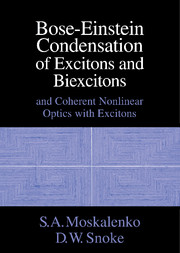Book contents
- Frontmatter
- Contents
- Preface
- 1 Introduction
- 2 Basic Theory of Bose–Einstein Condensation of Excitons
- 3 The Interaction of Condensed Excitons with Lattice Phonons
- 4 Bose–Einstein Condensation of Biexcitons
- 5 Phase Transitions and Thermodynamics of High-Density of Excitons
- 6 The Optical Stark Effect and the Virtual Bose Condensate
- 7 Bose–Einstein Condensation of Mixed States of Excitons and Photons
- 8 Nonequilibrium Kinetics of High-Density Excitons
- 9 Coherent Nonlinear Optics with Excitons
- 10 New Directions
- Appendix A: Properties of Excitons in Cu2O
- Author Index
- Subject Index
8 - Nonequilibrium Kinetics of High-Density Excitons
Published online by Cambridge University Press: 04 August 2010
- Frontmatter
- Contents
- Preface
- 1 Introduction
- 2 Basic Theory of Bose–Einstein Condensation of Excitons
- 3 The Interaction of Condensed Excitons with Lattice Phonons
- 4 Bose–Einstein Condensation of Biexcitons
- 5 Phase Transitions and Thermodynamics of High-Density of Excitons
- 6 The Optical Stark Effect and the Virtual Bose Condensate
- 7 Bose–Einstein Condensation of Mixed States of Excitons and Photons
- 8 Nonequilibrium Kinetics of High-Density Excitons
- 9 Coherent Nonlinear Optics with Excitons
- 10 New Directions
- Appendix A: Properties of Excitons in Cu2O
- Author Index
- Subject Index
Summary
Condensate Formation in the Bose Gas
An important question in connection with the experiments aimed at achieving BEC of a weakly interacting Bose gas with a finite lifetime is the time needed for the formation of the condensate. It is not at all evident that the condensation can always take place within the lifetime of the system. For the case of liquid He, the assumption of equilibrium seems satisfied because 4He atoms, which do not decay, undergo roughly 1011 interparticle-scattering events per second, assuming classical hard-sphere scattering. In other boson systems, however, nonequilibrium effects may have a significant effect. For excitons in a semiconductor, the lifetime of the particle may be only a few hundred scattering times. Spin-polarized hydrogen also has a finite lifetime to nonpolarized states [1], and alkali atoms can recombine into molecules [2]. Naively judging from classical behavior, one might assume that hundreds of scattering times may seem more than adequate time to establish equilibrium. The case of Bose condensation is unique, however, since a macroscopic number of particles must enter a single quantum state that by random-scattering processes alone is highly improbable. Therefore we need not assume that the time for Bose condensation is short.
Early experiments with orthoexcitons in CU2O seemed to indicate that the excitons might not have enough time to condense within their lifetime [3]. As discussed in Subsection 1.4.3, the orthoexciton density increased to approach the BEC boundary given in Eq. (1.18) and highly degenerate Bose-Einstein momentum distributions were observed, but a significant condensate fraction did not appear. Instead the gas increased its temperature to accommodate extra particles, reaching temperatures well above the lattice temperature.
- Type
- Chapter
- Information
- Bose-Einstein Condensation of Excitons and BiexcitonsAnd Coherent Nonlinear Optics with Excitons, pp. 295 - 335Publisher: Cambridge University PressPrint publication year: 2000



